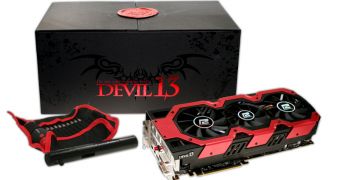The murmurs of dual-Tahiti graphics cards seemed to have died down, but now we see that it was just a means of luring NVIDIA customers into a false sense of security and vindication, regardless of whether or not it was intentional.
Conspiracy theories aside, we can now behold the first AMD dual-Radeon HD 7990 graphics adapter in all its glory.
We honestly didn't expect PowerColor to be the one to release one of these cards first. ASUS, with its ROG brand (Republic of Gamers), would have come to mind way before TUL Corporation.
Still, the Devil 13 HD7990 does, indeed, belong to PowerColor, so here is what it has and does.
The two Tahiti XT graphics processing units feature a speed of 925 MHz, but it is possible to push the frequency to 1 GHz when a certain BIOS setting is switched on.
The amount of VRAM backing the two chips is no less than 6 GB GDDR5, 3 GB for each chip. It operates at 1,375 MHz (5.5 Gbps) and the memory interface is 384 bits x 2.
Needless to say, DirectX 11.1 graphics, Eyefinity and CrossFireX are fully supported. The two DVI ports, one HDMI connector and two mini DisplayPort outputs make sure of it.
As for how this beast can pump enough electricity to support all these specifications, PowerColor went for 12+2+2 power phases, digital PWM, UHB, PowerIRStage and super cap. All in all, the beast should run stably and steadily, even in overclock mode.
That said, it goes without saying that PowerColor couldn't use just any cooling module on the product.
Sure enough, onlookers will notice three fans sitting atop a heatsink. Said fin array receives the heat from the GPUs and memory chips through U-shaped copper heatpipes.
Finally, TUL Corporations' PowerColor Devil 13 HD7990 boasts two BIOS'es, which can be toggled between thanks to a dual BIOS switch button. No price is known yet.

 14 DAY TRIAL //
14 DAY TRIAL //